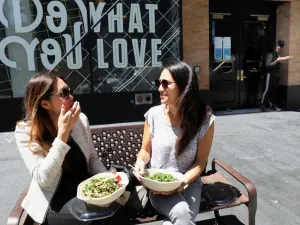Evidence is mounting that the American consumer’s back is starting to break. Accounting for almost 70 percent of the U.S.’s GDP, consumer spending grew 5.9 percent through 2023 despite high inflation and recession concerns, giving the economy a much-needed boost while the Federal Reserve hiked interest rates to combat inflation. Now, as the Fed maintains a higher-for-longer stance on interest rates to combat sticky inflation, consumers may need to bail out the economy one more time. Unfortunately, they may not be so willing this time around. The University of Michigan’s consumer sentiment index, a measurement of consumer spending confidence widely used by economists and policy makers, fell to its lowest in six months in May, sliding steeply to 67.4 from April’s 77.2. The figure fell below economist expectations surveyed by Bloomberg. Following a weak April jobs report and an uptick in inflation, consumers across all income, age and education groups revealed a declining interest in spending a few extra bucks.
Sign Up For Our Daily Newsletter
SIGN UP
Who is cutting back on spending and where?
Financial strain is intensifying for households situated at the lower end of the income spectrum. “What I worry about more than anything is that low-income households, in leisure and hospitality, have seen a fairly dramatic de-acceleration in wage gain, and are now trailing inflation” Diane Swonk, KPMG’s chief economist, told Observer.
Consumer resilience is also withering largely by their expectations for continued price growth. According to the University of Michigan survey, consumers anticipate a 3.5 percent increase in prices over the next year, the highest level in six months.
Katherine Cullen, the National Retail Federation’s (NRF) vice president of industry and consumer insights, told Yahoo Finance last week that shoppers of all income groups are seeing “shifts in their spending patterns” and are “really prioritizing what’s important to them.” The NRF predicts the retail industry will grow between 2.5 percent and 3.5 percent this year.
Starbucks, Sweetgreen, and other consumer giants are seeing similar trends. “Many customers have been more exacting about where and how they choose to spend their money,” Starbucks CEO Laxman Narasimhan told investors during an earnings call on April 30. Sweetgreen’s co-founder and CEO Jonathan Neman told CNBC last Friday (May 10), after the company reported strong quarterly sales, that its approximately $15 meals—typically targeted at lunch customers—are becoming more popular as dinner options because it’s the better value for consumers, “especially in the inflationary environment.”
“The battleground is with the low-income consumer. What you’re going to see is more attention to affordability,” McDonald’s CEO Chris Kempczinski said on an earnings call in February. To get customers back in its stores, McDonald’s is launching a $5 meal deal, which would be one of the most affordable fast food combos in the restaurant industry.
Morgan Stanley’s chief equity strategist Mike Wilson observed the same trend in the broader market, telling MSN, “Companies are increasingly focused on offering ‘value’ as the lower income cohort pulls back on spending and trades down.”
However, the picture is not as daunting as some may argue. “We have consumers slowing but not collapsing. Data on spending in the current quarter is coming in stronger than the last one because of incentives offered on things like vehicles,” KPMG’s Swonk said. “There are solid gains in consumer spending in services, that includes health care, legal services and household maintenance.”


